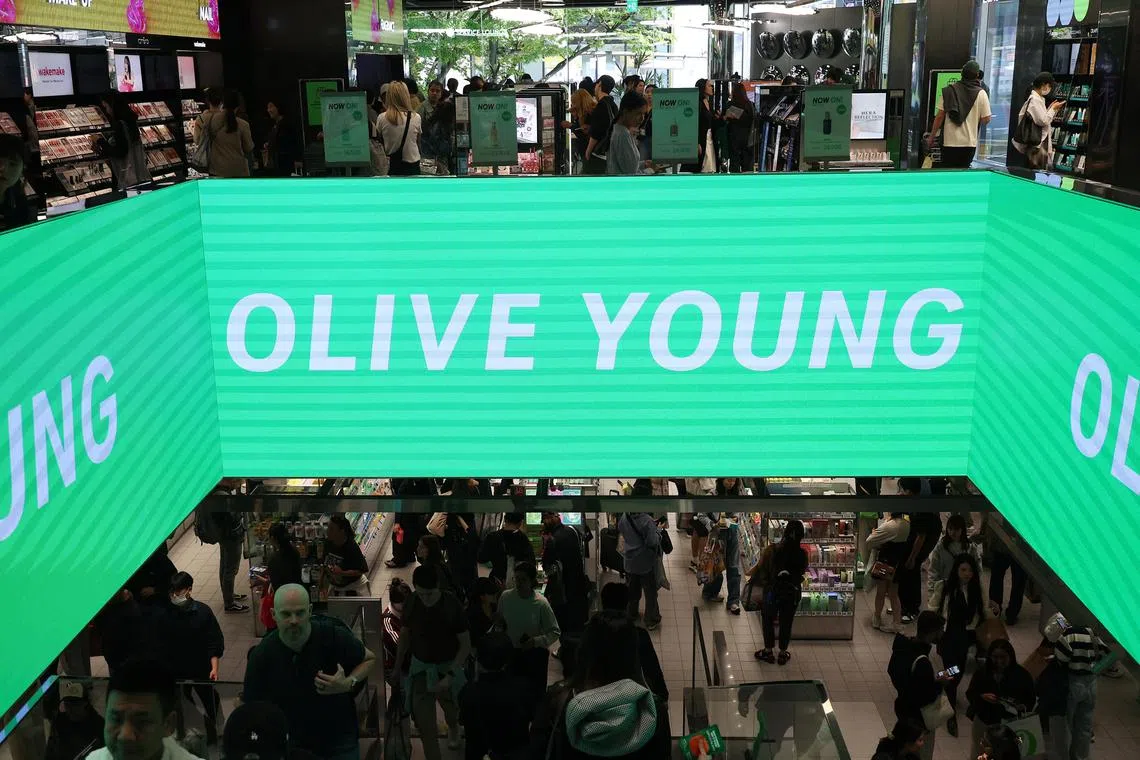K-pop in beauty stores: Olive Young diversifies as rivals gather
Sign up now: Get ST's newsletters delivered to your inbox

Olive Young’s expansion sets the stage for fiercer competition, particularly with Shinsegae’s beauty brand Chicor.
PHOTO: REUTERS
Follow topic:
SEOUL - Beauty retail giant CJ Olive Young is tightening its grip on Korea’s cosmetics market with a fresh push that fuses Korean cultural trends and hyper-personalised beauty experiences – all while sharpening its global edge.
With more than 1,300 stores nationwide, Olive Young has long dominated the local scene – and now it is doubling down. As new challengers emerge in Korea’s booming beauty space, the company is evolving its content strategy and store experience to stay ahead of the curve.
Olive Young’s new three-story Hongdae Playground outpost, which opened on June 11, features a dedicated men’s beauty zone, AI-powered skin scan consultations and K-pop sections.
Olive Young has increasingly tapped the power of K-pop, creating special zones in tourist hubs
The retailer said it held 19 K-pop pop-up stores in 2024, with six still operating. The strategy has roots in its online success. Since launching a K-pop category on its website in 2022, 71 per cent of first-time overseas customers who purchased K-pop albums also picked up K-beauty products.
More recently, Olive Young opened its Central Gangnam Town store on July 2, with a sharp focus on in-store beauty experiences such as skin analyses, personal colour diagnostics and bespoke consultations with beauty advisors.
“The opening of this advanced store seeks to meet the beauty needs of both local and international consumers in the Gangnam area,” an official from Olive Young said, adding that the retailer will continue to launch stores tailored to each district’s characteristics and customer base.
Olive Young’s expansion sets the stage for fiercer competition, particularly with Shinsegae’s beauty brand Chicor, which recently rebranded and opened nearby with a renewed focus on Korean products, shifting away from its earlier emphasis on imported labels.
Likewise, the Chicor store also offers customized beauty experiences, including an AI personalization service and a K-beauty makeup zone. Following in Olive Young’s footsteps, the retailer is eyeing new locations in tourist hotspots such as Hongdae and Myeong-dong.
Another potential competitor is Hyundai Home Shopping. The TV shopping operator is finalising plans to launch its first brick-and-mortar beauty store, Coasis, by October, which will be stocked with its teleshopping bestsellers. However, business specifics remain under wraps for now.
Although industry consensus remains that Olive Young’s dominance will not be easily toppled, the arrival of new competitors can only be good news for consumers.
“The popularity of K-beauty remains strong both here and abroad, and we’re seeing new players continue to enter the offline beauty market,” said an industry official. “But as the market grows, consumers will ultimately benefit from better quality and more competitive pricing.”
Indeed, data shows that K-beauty’s growth shows no signs of abating.
According to the Korea International Trade Association, Korea exported US$3.61 billion (S$4.6 billion) worth of cosmetics from January to April, surpassing the United States’
This milestone comes just a year after Korea overtook Germany to become the world’s third-largest cosmetics exporter, behind only France and the US.
The nation’s cosmetics exports in the first half of 2025 reached a record high of US$5.5 billion, up 14.8 per cent from a year earlier, according to data released by the Ministry of Food and Drug Safety. THE KOREA HERALD/ASIA NEWS NETWORK

